 |
CHAMÄLEON + ONJALA OBSERVATORY DeepSky | SITEMAP HOME CHAMÄLEON |
|
 |
|||
| « back to overview Star Clusters | Theta Orionis 1 Eta Carinae |
Object description Theta Orionis
1 Object description Eta Carinae |

Load large image without starlabels 1800 x 1200 Pixel — load large image with star labeling 1800 x 1200 Pixel
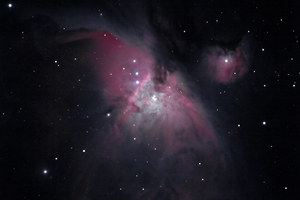 |
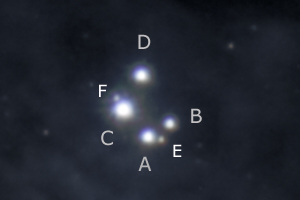 |
« « The outer left image shows the Orion trapezoid with the
inner part of the Great Orion Nebula. The image is a composite of 10 x 5 sec,
10 x 10 sec and 2 x 30 sec, taken on 26.4.2019 with an EOS 60DA (800 ASA) and
the 12.5" Planewave Astrograph with reducer at f = 2100mm.
Click here to load a large image. « The picture on the left shows the Theta Orion trapezoid with the 6 brighter components. Click here to load a large image.. Image data as above, but exposure 30 x 0.5 seconds. |
The trapezoidal stars are usually designated A, B, C and D in the order of ascending Right Ascension. The brightest of the four stars is C or Theta1 Orionis C, with an apparent brightness of 5.1mag. Both A and B have been identified as eclipsing variable stars.
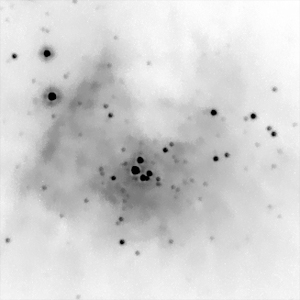 |
The
three brightest components on Theta Orionis 1, stars A, B and C, are all
multiple systems, with Theta B being a 6-fold star system. A and C have at
least 2 and the star D has 3 other components. The trapezoid is the center of a
large open star cluster. Most of the fainter stars are only visible in the red
and infrared spectral range (see left image). « The picture on the left shows an "ancient" CCD image of us, taken in the near infrared. It shows some of the brighter stars, the large open star cluster around the trapezoid stars. The wavelength of the IR edge filter was about 870nm, further image data are not available anymore. The bright trapezoidal stars were formed only about 1 to 2.5 million years ago directly from the material of the Orion Nebula, which has a diameter of about 24 light-years. Today they excite it to glow by ionization. Without the trapezoidal stars we would not be able to observe the Orion Nebula visually at all. The stars in the trapezoid together have masses of up to about 45 solar masses. They are a younger subgroup of the Orion Nebula cluster, which has a diameter of about 20 light-years and consists of about 3500 stars at a distance of less than 10 light-years around the trapezoidal stars. Many of the stars in the trapezoidal cluster have so-called protoplanetary disks of gas and dust and are apparently solar systems in the making. |
The discoverer of three of the four trapezoidal stars is Galileo Galilei. He saw the three brighter components A, C and D and noted that the stars A and D are about the same brightness and have the same distance to component C. Seen with the naked eye, the trapezoidal stars appear as a single star, so Theta 1 Orionis was the first star to be resolved into several components with a telescope.
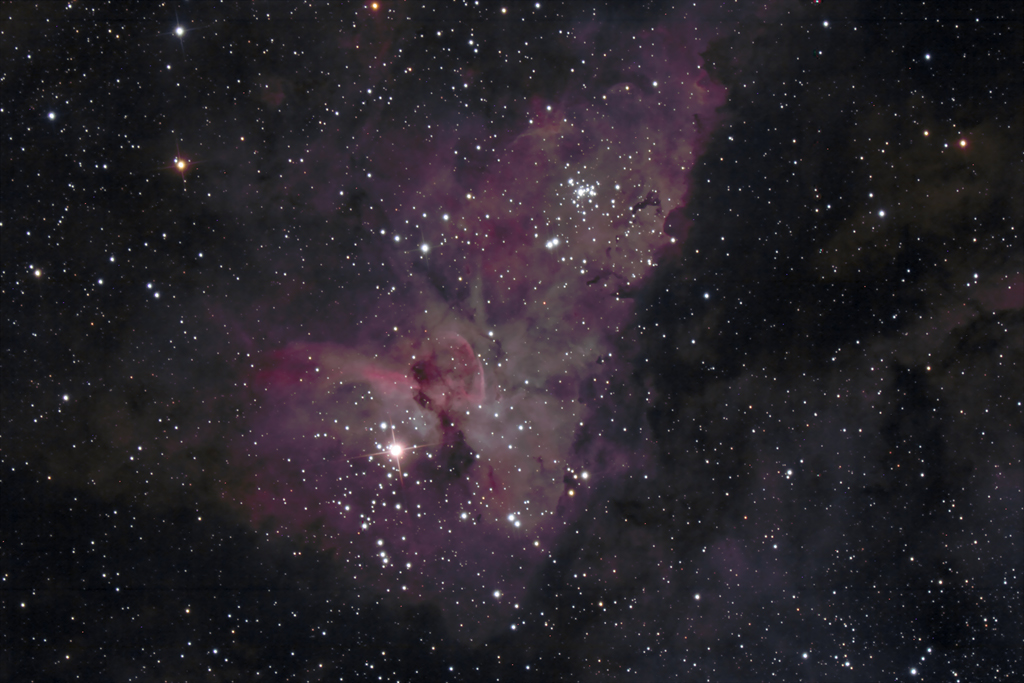
load large image without object labeling 1800 x 1200 Pixel — load large image with object labeling 1800 x 1200 Pixel
Eta Carinae is a variable, extremely massive double star of about 100 to 200 solar masses for the primary star, or 30 to 80 solar masses for the secondary star, which radiates with about four to five million times the luminosity of our Sun. The accompanying secondary star can only be detected by fluctuations in the spectrum of Eta Carina and therefore cannot be observed directly. More recent observations even suggest a triple system.
Eta Carinae is located at a distance of about 7,500 light-years, within the open star cluster Trumpler 16, which in turn is embedded in a very large nebula complex, the Carinae Nebula NGC 3372. It belongs to the so-called hypergiants and thus to the luminous blue variable stars. It is one of the most massive stars in our Milky Way. The fact that Eta Carina appears clearly red on a visual observation is due to the bipolar planetary nebula surrounding the star, the Homunculus Nebula.
The star is remarkable because of its eruptions and the resulting strong changes in brightness. At its first cataloguing by Edmond Halley in 1677 it was a star of the 4th magnitude. However, it slowly increased its brightness and in 1730 it was perceived as one of the brightest stars in the constellation Kiel of the ship (Carinae). Until 1782 its former brightness decreased and then gradually increased again from 1820 on. In 1827 it was already ten times as high, corresponding to 2.5 magnitudes, and between 1837 and 1856 there was a huge eruption, during which it finally reached a brightness of - 1 magnitude around 1843. The eruption had the extent of a supernova and made Eta Carinae the second brightest star after Sirius within a very short time despite its distance.
In the following years it faded visibly. From 1900 to 1940 it was with 7th - to 8th magnitude only visible in the telescope. From 1940 it gradually became brighter again and again observable with the naked eye. From 1998 to 1999 the star doubled its brightness within 18 months and had reached a brightness of the 5th to 6th magnitude in 2002. Currently, in 2019, the brightness is close to the 7th magnitude.
Previous outbursts:
Further away from the Homunculus Nebula, older ejecta are found, possibly ejected during a similar eruption in the 15th century. Images taken by the Chandra X-ray satellite in 1999 also show a horseshoe-shaped ring with a diameter of about 2 light-years, from which another large eruption more than a thousand years ago is suggested. In any case, they show that the star is highly unstable and has reached the end of its life cycle. It is assumed that it will undergo a major eruption at least once in a thousand years and that it will probably explode as a supernova within the next 100,000 years.
The open star clusters Trumpler 14, 16 and Collinder 282
Trumpler 16, Trumpler 14 and Collinder 282 are the most important star clusters in the Carina star formation region. The estimated age of the stars is about 300,000 to 500,000 years, making them among the youngest and many of them also among the most luminous stars in our Milky Way. The star clusters lie at a distance of about 7,500 to 9,000 light years from the solar system.
Herschel's "keyhole nebulae
Right next to Eta Carinae is "Herschel's Keyhole Nebula". Its optical appearance is closely linked to the brightness variations of Eta Carinae. The "keyhole" consists partly of dark clouds, which obscure the view to regions behind. The dark, semi-circular upper structure is more like a hollow in the dark cloud. This cavity seems to be expanding and has its own name, it is the so-called Eta Carinae-II-Ring. In 1843 Herschel still saw bright nebulous parts in the southern part of the nebula, which have completely disappeared today. Today they are interpreted as reflection nebulae, which were then still directly illuminated by Eta Carina. Further information and historical drawings of the keyhole fog are shown here ...
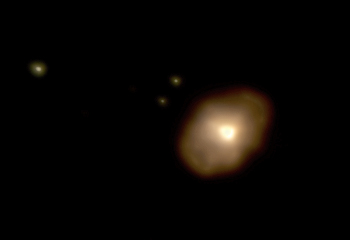 |
The Homunculus
nebulae « The so-called Homunculus Nebula (Latin for "little man"). Image data: Celestron C14 focal at f = 3.900mm, video module ZWO ASI 224 C, 2.000 single images at t = 200 msec, stacking 30%. Series of pictures from 19.05.2019. Image processing: Bernd Gooßmann The homunculus is a small bipolar planetary nebula surrounding the star Eta Carinae. It has a maximum longitudinal expansion of about 18 arcseconds and at a distance of 7,500 light years this corresponds to about 0.5 light years. The propagation speed of the nebula measured over a period of 50 years gives an average of 700km/s. Thus the formation of the nebula can be dated to the year 1840 when the star Eta Carina underwent its great eruption. This emission of matter is probably associated with is |
 |
 |
 |
 |
 |
 |
 |
| Sun | Moon | Solar System | DeepSky | Widefield | Miscellaneous | Spec. Projects |